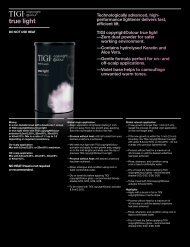For The Love Of Colour - TiGi
For The Love Of Colour - TiGi
For The Love Of Colour - TiGi
You also want an ePaper? Increase the reach of your titles
YUMPU automatically turns print PDFs into web optimized ePapers that Google loves.
a closer look<br />
at hair<br />
<strong>The</strong> hair is made up of three<br />
distinct areas that are formed<br />
inside the follicle.<br />
<strong>The</strong> cells flatten and harden<br />
as they move up, arranging<br />
themselves into Cuticle,<br />
Cortex, and Medulla.<br />
CuTICLE<br />
CORTEx<br />
MEDuLLA<br />
hair science<br />
Cuticle<br />
<strong>The</strong> outside of hair is made up of cuticle<br />
scales that are approximately 7-10 layers thick.<br />
<strong>The</strong> scales overlap and form a smooth surface<br />
from root to tip, sliding over each other as hair<br />
is stretched. <strong>The</strong> function of the cuticle layer<br />
is to protect the internal hair structure.<br />
Tightly closed cuticles help to preserve hair’s<br />
natural moisture, allowing natural lubricants<br />
from the scalp to travel down the hair shaft.<br />
This forms a smooth even surface which reflects<br />
light evenly, making hair appear shiny and glossy.<br />
<strong>The</strong> cuticles are transparent, allowing<br />
the natural colour from inside the hair to be seen.<br />
When hair is wet, water molecules enter the<br />
spaces between the cuticle scales, allowing the<br />
cuticle to open slightly and the hair to expand.<br />
A healthy cuticle will be tightly closed when the<br />
hair is dry and remain smooth when it is wet,<br />
protecting the hair effectively.<br />
<strong>The</strong> cuticle is the first line of defence against<br />
environmental damage and will often show<br />
signs of wear and tear. Influencing factors include<br />
hair length, sun exposure, brushing and combing<br />
(especially when the hair is wet), repeated blow<br />
drying, application of heat from styling, and<br />
extreme use of chemical treatments. All of these<br />
will cause the cuticle scales to lift, allowing<br />
moisture and lipids to be lost. This loss of moisture<br />
means that hair tangles easily, making it look dull<br />
and feel rough. When the cuticle is open, the hair<br />
will be able to absorb more water, often taking<br />
longer to dry and requiring more product when<br />
carrying out haircolouring services.<br />
Hair in this state is described as porous. It is<br />
important to remember that the cuticle may be<br />
compact and smooth at the root, becoming raised<br />
towards the ends, so porosity is often varied along<br />
the length. Conditioners are used to smooth and<br />
coat the cuticle, making hair easier to comb by<br />
replacing moisture and restoring shine.<br />
CuTICLE CORTEx<br />
CuTICLE<br />
CORTEx<br />
hair science<br />
Cortex<br />
<strong>The</strong> cortex is the main body of the hair, forming<br />
90% of the hair’s weight. <strong>The</strong> cortex contains<br />
the natural moisture, proteins, lipids, and natural<br />
colour of hair and is where all chemical services<br />
take place. Lipids are essential fatty acids that<br />
help to hydrate and protect cells by binding<br />
moisture to the hair. By maintaining moisture<br />
levels, lipids help to create shine; loss of lipids,<br />
therefore, can lead to dry and dull hair.<br />
<strong>The</strong> structure of the cortex is important because<br />
it is responsible for the elasticity of hair. Keratin in<br />
the cortex is formed into an alpha helix, a springlike<br />
structure held together by bonds. It is this<br />
structure that allows the hair to be stretched up to<br />
50% in length and spring back to its original state<br />
without damage, making it strong, resilient, and<br />
bouncy. This structure also makes it possible for<br />
hair to be styled by wetting, stretching into a new<br />
shape, and drying to retain the shape temporarily.<br />
<strong>The</strong>re are three types of bonds in hair holding<br />
the alpha helix together:<br />
— Salt bonds – easily broken and reformed.<br />
— Hydrogen bonds – easily broken by water<br />
and reformed.<br />
— Disulphide bonds – difficult to break,<br />
can only be broken by chemical process<br />
such as perming, relaxing, or straightening.<br />
Excessive chemical treatments will cause the<br />
internal structure of keratin to break down,<br />
causing permanent damage to the bonds and<br />
loss of elasticity which makes hair limp, lifeless,<br />
and difficult to style. Conditioning treatments<br />
can help by restoring protein to help rebuild<br />
the internal structure of hair, strengthening<br />
from the inside.<br />
Excessive processing or misuse of chemical<br />
product can damage the internal structure<br />
of the hair.<br />
An elasticity test is used to determine internal<br />
damage. When internal damage has occurred,<br />
we describe the hair as being sensitised.<br />
Medulla<br />
<strong>The</strong> medulla is not always present, and has<br />
no known function. It consists of an irregular<br />
honeycomb structure of air spaces in the<br />
centre of the hair and may not be<br />
continuous along the length.<br />
MEDuLLA




